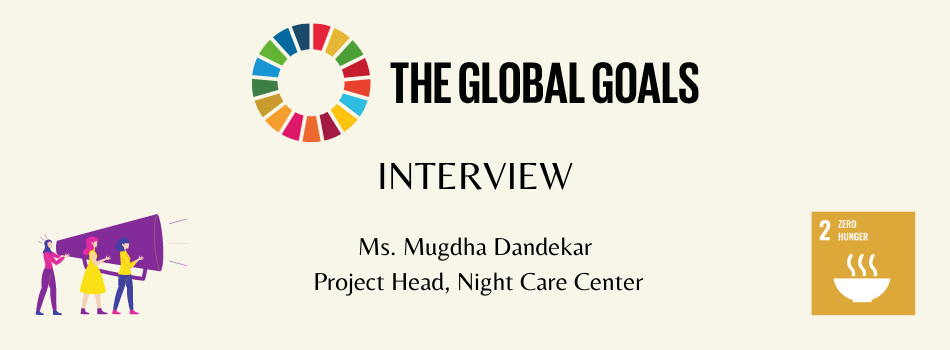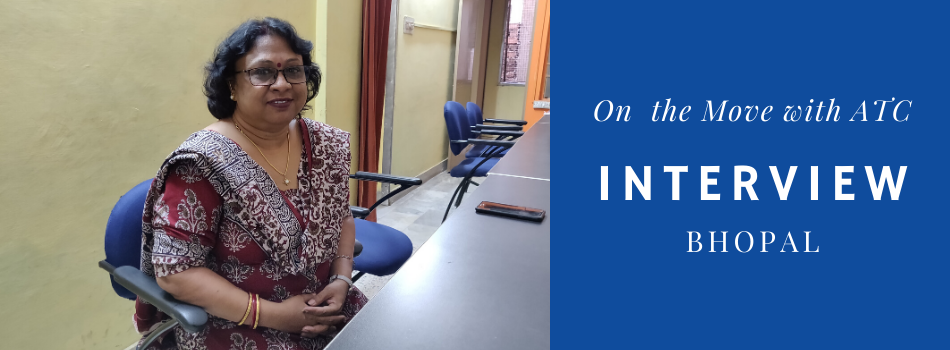
SDG Goal 2: Understanding Prerana's interventions in ensuring access to nutritional food and ration relief
Shatakshi Saxena
Project Coordinator (Documentation and Communications)
Ms. Mugdha Dandekar had joined Prerana as a Project Coordinator in 2006, and has been a part of our team for over 15 years. She is currently the Program Head of Night Care Center and monitors our three NCCs at Kamathipura, Falkland Road and Vashi Turbe. She also coordinates with donors, is involved in documentation along with monitoring and evaluation.
How does Prerana’s Night Care Center’s (NCC) nutrition plan contribute towards ensuring nutritious and sufficient food for the children availing its facilities?
Prerana has been working with women in the red-light areas of Kamathipura, Falkland Road and Vashi Turbe and their children for over three decades. Our Night Care Center (NCC) Program was initiated as a response to an expressed need of women in the sex trade to keep their children in a safer place, away from the red-light area during the unsafe night hours. Since the women in the sex trade have to be available for their clients at night, they rest during the day and with the control that the perpetrators have on their time, it is difficult for them to pay attention on their children’s nutritional intake and health. In the nutrition plan at our NCC, we provide 5 meals to children, which includes breakfast, lunch, quick mid-afternoon snack, an evening snack and dinner. Our aim is to ensure that children get access to a balanced and healthy diet. While deciding the menu, children are involved in the discussion and their likes/dislikes and suggestions are considered at every step. Sometimes, children don’t like eating a particular lentil or vegetable that has nutritional value. In such cases, we find a solution together. The menu is revised and changed every 3-4 months so that children don’t find it monotonous. We also consult a nutritionist before finalizing the menu.
As a practice, the food cooked for children is tasted by a team member present at the center one hour before it is served. The purpose is to check the quality e.g. spice levels, if it is too oily or less cooked etc. We also have a policy document that elaborates on the number of meals in a day and the detailed menu for each day such as eggs are served twice a week, and chicken is served once a month. We also include quick noodles in the menu once a month as it is liked by all the children and strongly suggested by them. This policy document is reviewed every 1-2 years to incorporate any suggestions received from children, their mothers, the visiting doctor, the nutritionist or the staff members. I recall almost 10 years ago we would have had 20-22 children testing positive for tuberculosis at the time of admission into the NCC. After dedicated attention on timely checkups, awareness on hygienic behavior and nutrition and well-planned diet plan and nutritional intake at the NCC, we now have zero cases of tuberculosis at our center.
What rules regarding nutrition are mandated under the Juvenile Justice Act (Care and Protection of Children, 2015) for Child Care Institutions and shelter homes?
Under Section 35 of Maharashtra State Juvenile Justice Act (Care and Protection of Children), 2015, it is mandatory to provide 4 meals, namely breakfast, lunch, evening snack and dinner, to children residing in Child Care Institutions . At our NCC, we have always followed a 5 meal pattern. Section 36 of the Maharashtra State Juvenile Justice Act (Care and Protection of Children), 2015, elaborates on conducting malnutrition screening and providing special meals accordingly. We have been following this as well, and our special meals are designed after consultation with the nutritionist on case to case basis.
What is the role of children’s participation in deciding the food menu?
We strongly believe in child participation and strive to ensure that in every program. Children residing at our NCC actively participate in deciding the menu. During the discussion, we inform them about the budget and what all can be accommodated in the same. This also helps children make informed decision for something that affects them directly. We have a nutrition committee with children as its members. Along with the staff they too participate in regularly monitoring that food is not wasted and discuss the likes and dislikes of all children. We also conduct various sessions to explain children about concepts such as protein, vitamins, carbohydrates etc., and which foods hold high nutritional value. At Prerana, we believe it is imperative to interact with the mothers of these children and help them understand everything that their children are a part of, or are provided at our NCC. This ensures that the mothers are directly involved in the growth and development cycle of their children. We hold meetings with the mothers to explain nutrition and how it impacts their children so they’re able to guide them better. I remember a mother had once shared with us, “Meri beti ki sehat pehle se bahut behtar hogayi hai. Wo zyada khush aur swastha lagti hai. Kya khilate hain aap log usse, mai zarur janna chahungi.” (My daughter’s health has improved since the last time. She seems happier and healthier. What is her diet, I would really like to know?)
During the pandemic induced lockdown, how did Prerana ensure that women in the red-light areas were able to access food?
When the COVID-19 induced lockdown was announced, women in the sex trade had no source of income left. The lockdown had made them and their children more vulnerable to exploitation, especially with schools and some open shelters shut. Since women had no money to purchase ration and our NCC was temporarily non-functional, children were being deprived of appropriate nutrition and balanced meals. Our team with assistance from the Rationing Commissioner assisted over 400 women in the red-light areas between April 2020 and March 2021. This helped them access ration from the Public Distribution System. Between April 2020 and March 2021, our NCC team assisted over 400 women in the red-light areas access ration cards/food cards. Every ration card holder received 3kg wheat and 2kg rice per month.
When our team was informed that women could receive 10kg free rice under Shramik Aana Dhania Puravtha Yojna, we coordinated with the women from Kamathipura and Falkland Road, the Ration office and the Ration shops. 550 women were able to access the free rice from the Public Distribution System on the basis of their Aadhar cards between June and August 2020. During the first wave of COVID-19, we distributed 3550 ration kits in all three red-light areas. The grocery in these relief kits had supplies enough to support a family of 4 people for a month. For women whom we could not reach due to travel restrictions, we linked them to other organizations in the said areas for ration assistance. Throughout the pandemic, we followed-up telephonically to ensure women were able to access ration. Our team actively worked to spread awareness amongst mothers that their children’s schools had been distributing free ration supplies so they’re able to access it in time.
Prerana also works with women who are HIV positive and assists them with access to nutritional food. Could you elaborate on this program?
At both Kamathipura and Falkland Road centers we have groups with 25 women as members who are HIV positive. We conduct health related sessions with a health counselor for the women to help them understand the importance of a balanced, planned and nutritious diet. We also ensure to distribute ration kits to them and thoroughly followed up on the same during the lockdown. We also followed-up with them regarding their medication as the pandemic had created trouble accessing it. Our teams assisted the women get their ration card/food card issued so they’re able to access ration from the Public Distribution System. We also linked them up with other sources who were distributing dry food items and hygiene kits.
This is the sixth interview in the ten-month long series on Prerana’s commitment to sustainable development goals. Watch this space for more.
To be or not to be? Questions on motherhood searching answers
Over the past few years, Prerana’s Anti-trafficking Center (ATC) has been instrumental in documenting challenges while working on anti-human trafficking Read more
Over the past few years, Prerana’s Anti-trafficking Center (ATC) has been instrumental in documenting challenges while working on anti-human trafficking Read more



